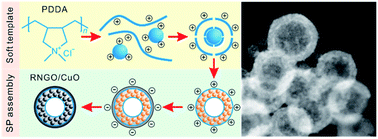Structure-tunable supraparticle assemblies of hollow cupric oxide sheathed with nanographenes†
Abstract
Self-assembled supraparticles (SPs), a secondary structure of clustered nanoparticles, have attracted considerable interest owing to their highly tunable structure, composition, and morphology from their primary nanoparticle constituents. In this study, hierarchically assembled hollow Cu2O SPs were prepared using a cationic polyelectrolyte poly(diallyl dimethylammonium chloride) (PDDA) during the formation of Cu2O nanoparticles. The concentration-dependent structural transformation of PDDA from linear chains to assembled droplets plays a crucial role in forming a hollow colloidal template, affording the self-assembly of Cu2O nanoparticles as a secondary surfactant. The use of the positively charged PDDA also affords negatively charged nanoscale graphene oxide (NGO), an electrical and mechanical supporter to uniformly coat the surface of the hollow Cu2O SPs. Subsequent thermal treatment to enhance the electrical conductivity of NGO within the NGO/Cu2O SPs allows for the concomitant phase transformation of Cu2O to CuO, affording reduced NGO/CuO (RNGO/CuO) SPs. The uniquely structured hollow RNGO/CuO SPs achieve improved electrochemical properties by providing enhanced electrical conductivity and electroactive surface area.



 Please wait while we load your content...
Please wait while we load your content...